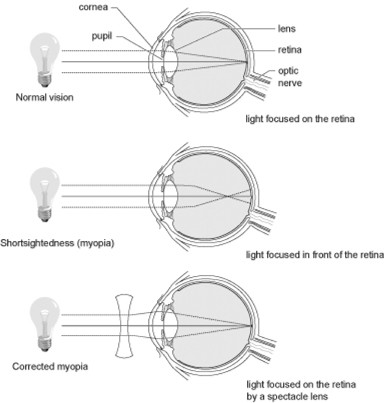Myopia
What is myopia?Myopia, also known as nearsightedness, is a common type of refractive error where close objects appear clearly, but distant objects appear blurry. What is high myopia?High myopia is a severe form of the condition. In high myopia, the eyeball stretches and becomes too long. This can lead to holes or tears in the retina and can also cause retinal detachment. Abnormal blood vessels may grow under the retina and cause changes in vision. People with high myopia need comprehensive dilated eye exams more often. Early detection and timely treatment can help prevent vision loss. |
 |
Causes and Risk Factors
How does myopia develop?
Myopia develops in eyes that focus images in front of the retina instead of on the retina, which results in blurred vision. This occurs when the eyeball becomes too long and prevents incoming light from focusing directly on the retina. It may also be caused by an abnormal shape of the cornea or lens.
Who is at risk for myopia?
Myopia can affect both children and adults. Myopia is often diagnosed in children between 8 and 12 years of age and may worsen during the teen years. Little change may occur between ages 20 to 40, but sometimes myopia may worsen with age. People whose parents have myopia may be more likely to get the condition.
Symptoms and Detection
What are the signs and symptoms of myopia?
Some of the signs and symptoms of myopia include:
- Headaches
- Eyestrain
- Squinting
- Difficulty seeing distant objects, such as highway signs
How is myopia diagnosed?
An eye care professional (e.g. optometrist/ophthalmologist) can diagnose myopia and other refractive errors during a comprehensive dilated eye examination. People with this condition often visit their eye care professional with complaints of visual discomfort or blurred distant vision.
Treatment
How is myopia corrected?
Myopia can be corrected with eyeglasses, contact lenses, or surgery.
Eyeglasses are the simplest and safest way to correct myopia. Your eye care professional can prescribe lenses that will correct the problem and help you to see your better. And there is a special lens called myopia-control lens which may be helpful to hold the progress.
Contact Lenses work by becoming the first refractive surface for light rays entering the eye, causing a more precise refraction or focus.
Refractive Surgery aims to permanently change the shape of the cornea which will improve refractive vision. Surgery can decrease or eliminate dependency on wearing eyeglasses and contact lenses.
Source: National Eye Institute



